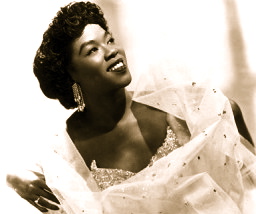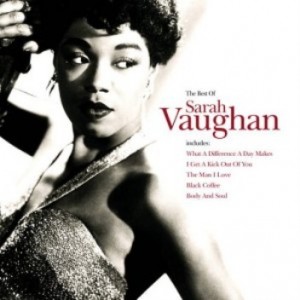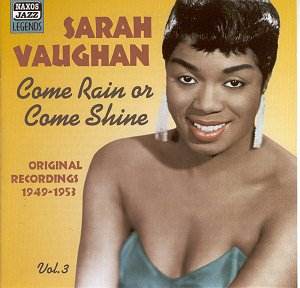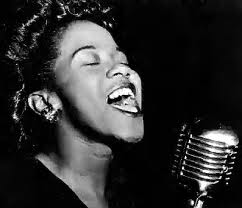Sarah Vaughn

Sarah Vaughan “Live From Monterey” (1984)
 Sarah Lois Vaughan (March 27, 1924 – April 3, 1990) was an American jazz singer, described by Scott Yanow as having “one of the most wondrous voices of the 20th century.”
Sarah Lois Vaughan (March 27, 1924 – April 3, 1990) was an American jazz singer, described by Scott Yanow as having “one of the most wondrous voices of the 20th century.”
Nicknamed “Sailor” (for her salty speech), “Sassy” and “The Divine One“, Sarah Vaughan was a Grammy Award winner. The National Endowment for the Arts bestowed upon her its “highest honor in jazz”, the NEA Jazz Masters Award, in 1989.
Beginnings: 1942–1943
Biographies of Vaughan frequently stated that she was immediately thrust into stardom after a winning Amateur Night performance at Harlem‘s Zeus Theater. In fact, the story that biographer Renee relates seems to be a bit more complex. Vaughan was frequently accompanied by a friend, Doris Robinson, on her trips into New York City. Sometime in the fall of 1942 (when Sarah was 18 years old), Vaughan suggested that Robinson enter the Apollo Theater Amateur Night contest. Vaughan played piano accompaniment for Robinson, who won second prize. Vaughan later decided to go back and compete herself as a singer. Vaughan sang “Body and Soul” and won, although the exact date of her victorious Apollo performance is uncertain. The prize, as Vaughan recalled later to Marian McPartland, was US$10 and the promise of a week’s engagement at the Apollo. After a considerable delay, Vaughan was contacted by the Apollo in the spring of 1943 to open for Ella Fitzgerald.
 Sometime during her week of performances at the Apollo, Vaughan was introduced to bandleader and pianist Earl Hines, although the exact details of that introduction are disputed. Billy Eckstine, Hines’ singer at the time, has been credited by Vaughan and others with hearing her at the Apollo and recommending her to Hines. Hines also claimed to have discovered her himself and offered her a job on the spot. Regardless, after a brief tryout at the Apollo, Hines officially replaced his existing male singer with Vaughan on April 4, 1943.
Sometime during her week of performances at the Apollo, Vaughan was introduced to bandleader and pianist Earl Hines, although the exact details of that introduction are disputed. Billy Eckstine, Hines’ singer at the time, has been credited by Vaughan and others with hearing her at the Apollo and recommending her to Hines. Hines also claimed to have discovered her himself and offered her a job on the spot. Regardless, after a brief tryout at the Apollo, Hines officially replaced his existing male singer with Vaughan on April 4, 1943.
With Earl Hines and Billy Eckstine: 1943–1944
Vaughan spent the remainder of 1943 and part of 1944 touring the country with the Earl Hines big band that also featured baritone Billy Eckstine. Vaughan was hired as a pianist, reputedly so Hines could hire her under the jurisdiction of the musicians’ union (American Federation of Musicians) rather than the singers union (American Guild of Variety Artists), but after Cliff Smalls joined the band as a trombonist and pianist, Sarah’s duties became limited exclusively to singing. This Earl Hines band is best remembered today as an incubator of bebop, as it included trumpeter Dizzy Gillespie, saxophonist Charlie Parker (playing tenor saxophone rather than the alto saxophone that he would become famous with later) and trombonist Bennie Green. Gillespie also arranged for the band, although a recording ban by the musicians union prevented the band from recording and preserving its sound and style for posterity.
Eckstine left the Hines band in late 1943 and formed his own big band with Gillespie, leaving Hines to become the new band’s musical director. Parker came along too, and the Eckstine band over the next few years would host a startling cast of jazz talent: Miles Davis,Kenny Dorham, Art Blakey, Lucky Thompson, Gene Ammons, Dexter Gordon, among others.
 Vaughan accepted Eckstine’s invitation to join his new band in 1944, giving her an opportunity to develop her musicianship with the seminal figures in this era of jazz. Eckstine’s band also afforded her first recording opportunity, a December 5, 1944 date that yielded the song “I’ll Wait and Pray” for the Deluxe label. That date led to critic and producer Leonard Feather to ask her to cut four sides under her own name later that month for the Continental label, backed by a septet that included Dizzy Gillespie and Georgie Auld.
Vaughan accepted Eckstine’s invitation to join his new band in 1944, giving her an opportunity to develop her musicianship with the seminal figures in this era of jazz. Eckstine’s band also afforded her first recording opportunity, a December 5, 1944 date that yielded the song “I’ll Wait and Pray” for the Deluxe label. That date led to critic and producer Leonard Feather to ask her to cut four sides under her own name later that month for the Continental label, backed by a septet that included Dizzy Gillespie and Georgie Auld.
Band pianist John Malachi is credited with giving Vaughan the moniker “Sassy”, a nickname that matched her personality. Vaughan liked it and the name (and its shortened variant “Sass”) stuck with colleagues and, eventually, the press. In written communications, Vaughan often spelled it “Sassie”.
 Vaughan officially left the Eckstine band in late 1944 to pursue a solo career, although she remained very close to Eckstine personally and recorded with him frequently throughout her life.
Vaughan officially left the Eckstine band in late 1944 to pursue a solo career, although she remained very close to Eckstine personally and recorded with him frequently throughout her life.

